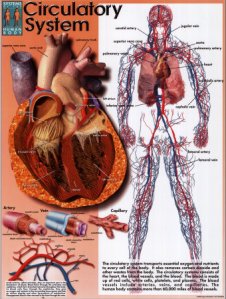The Cardiovascular System: Difference between revisions
No edit summary |
No edit summary |
||
| Line 1: | Line 1: | ||
The Cardiovascular System (also called circulatory system) circulates the blood around the body in order to supply all parts with required nutrients and [[Image:Cardiovascularsystem.jpg|frame|right | The Cardiovascular System (also called circulatory system) circulates the blood around the body in order to supply all parts with required nutrients and [[Image:Cardiovascularsystem.jpg|frame|right]][[Oxygen|oxygen]] and to remove waste products such as [[Carbon dioxide|carbon dioxide]] <ref name="parker"> Parker S. (2007) The Human Body Book, 1st edition, London: Dorling Kindersley Limited.</ref>. Consequently it is crucial of the body's maintenance of [[Homeostasis|homeostasis]].<ref name="website">http://stayhealthier.wordpress.com/2010/03/30/cardiovascular-system-understand-it-to-stay-healthy/</ref><br> | ||
In order to carry out its functions, the cardiovascular system pumps blood through the blood vessels. This is done by the pumping of the heart. Furthermore, the circulatory system is associated with other systems in the body, for example the lymphatic system.<ref name="parker" /> | |||
<br> | <br> | ||
Revision as of 13:11, 2 December 2011
The Cardiovascular System (also called circulatory system) circulates the blood around the body in order to supply all parts with required nutrients and

oxygen and to remove waste products such as carbon dioxide [1]. Consequently it is crucial of the body's maintenance of homeostasis.[2]
In order to carry out its functions, the cardiovascular system pumps blood through the blood vessels. This is done by the pumping of the heart. Furthermore, the circulatory system is associated with other systems in the body, for example the lymphatic system.[1]
Blood and Blood Vessels
Blood consists of white blood cells, red blood cells, platelets and liquid plasma. Plasma accounts for about 50% of the total blood content and contains mainly water which has glucose, enzymes and other proteins, hormones and waste products dissolved in it. Oxygen and carbon dioxide are also present in the blood and are carried by the red blood cells.[1]
Within the human body, blood is carried in blood vessels which can differ in size and makeup [1].
Arteries
innitiate from the heart and carry blood to organs and tissues where oyxgen and nutrients are needed. Therefore, they carry blood which is rich in these components. The arteries pump blood by narrowing as the heart relaxes, so that the exerted force pushed the blood forward. Thick walls, muscular (see cardiac muscle), and elastic layers ensure that the strain due to the blood flow and the contraction of the heart does not damage the walls, which on average are only 1mm thick [1].
Veins
Capillaries
Heart Structure
Coronary Heart Disease
References